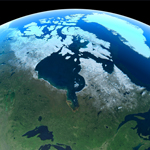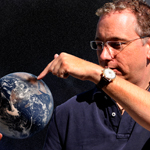
Remote Sensing
This module provides an overview of the use of satellite and airborne remote sensing imagery in forestry and conservation, and some interesting and novel applications.
Learning Objectives
After viewing this presentation and relevant support material, users should be able to:
- Describe the variety and capabilities of past and current space borne sensors.
- Explain the nature of the information content in currently available remotely sensed imagery and how to extract this.
- Describe the spectral properties of the Earth surface and how these can be used to interpret vegetation and other aspects of the environment.
- Detail the way in which pixel properties are a mixture of the various components within that pixel and how these can be unmixed to produce abundance maps.
- Give a simple description of the role of image processing in the management of spatial geoscience data.
Presenter
Listen to Dr. Coops respond to the question: How did I get interested in this area of study?
For more information about Dr. Coops, please check UBC, Faculty of Forestry
Module Resources
Presentation
Dr. Nicholas Coops describes examples of images with various spatial resolution produced by a range of satellites. Most remote sensing image production is from photographing the radiation energy that is reflected off objects. Cameras can distinguish objectives in a much broader range than only the narrow wavelength band reflected by visible light. Thus objects which resemble each other closely in the visible spectrum can be distinguished from each other in another band of wavelengths.
Laboratory videos
 Lab1: How to interprete a landsat satellite image.
Lab1: How to interprete a landsat satellite image.
This lab video takes place in the Remote Sensing Laboratory in the Forest Sciences Building. Dr. Coops demonstrates the interpretation of images originating from a Landsat Satellite. Images can be displayed by single spectral band or in composite with different spectral bands assigned to certain colour guns on the computer.
 Lab 2: How to use a Spectral Radiometer
Lab 2: How to use a Spectral RadiometerThis video takes place in the forest where Trevor demonstrates the use of a spectral radiometer. This device measures the reflective properties of various earth surface materials such as tree bark and leaves. The multiple sensors in the machine measure different portions of the electromagnetic spectrum; this information is correlated with output from remote sensing.
Other Resources
- Lillesand, T. M., Kiefer, R. W. and Chipman, J (2007) Remote Sensing and Image Interpretation (6th Ed). Wiley and Sons, New York
- Jensen, J.R (2000) Remote Sensing of the Environment: An Earth Resource Perspective, 2nd Edition, Prentice-Hall 544p
- Remote Sensing. Projects and Technologies, Canadian Forest Service, Natural Resources Canada
Potential Questions for Instructors
- Remote sensing technology uses a number of regions of the electro-magnetic spectrum. Which parts of the spectrum are good for vegetation analysis and discrimination ? Within the visible part of the spectrum what wavelengths are good for discriminating water and soil ?
- Name two applications which would be well suited to MODIS type satellite imagery (large pixel size (1km) and short revisit time (1 day) ? What environmental applications are better suited to moderate spatial resolution (30 – 100m) longer revisit times (2 weeks) ? List two applications.
- What are the fundamental differences between RADAR and the other remote sensing systems discussed in the presentation? What could be an advantage of a RADAR system over other systems?

